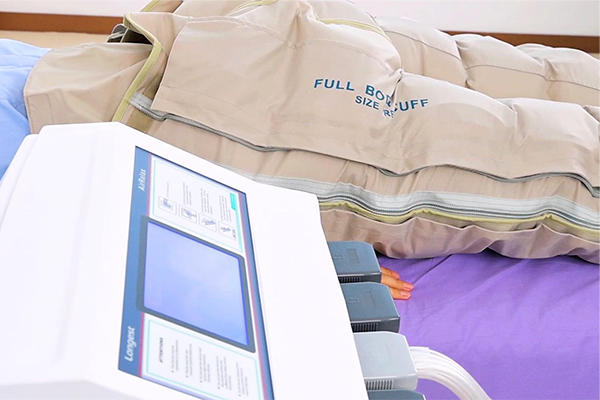Intermittent Pneumatic Compression As An Effective Supplement Treatment for Lymphedema
Pneumatic compression pumps are strongly recommended as a treatment for patients with lymphedema, especially for those who have failed conservative measures.
What’s lymphedema?
Lymphedema occurs when lymph fluid is accumulated abnormally in subcutaneous tissues or body cavities resulting from obstruction of lymphatic flow. They are two types of lymphedema: primary lymphedema and secondary lymphedema.
Primary lymphedema is idiopathic and results from the maldevelopment of the lymphatic system. Primary lymphedema occurs at all ages but is a relatively rare condition, affecting 1 in 100,000 people.
Secondary lymphedema is more common compared with the primary, with over 200 million people suffering from this condition worldwide. It is acquired and caused by a variety of outside factors, including cancer, cancer treatment, infection, trauma, parasites, and other health conditions that affect the body’s ability to remove excess fluid.
Who is most at risk of developing secondary lymphedema?
- Who has been treated for cancer where the lymph nodes have been removed or damaged, such as treated for breast cancer, melanoma, gynecological, and prostate cancer.
- Who has wounds, trauma, infection (cellulitis and fungal infections)
- Who are obese or immobile
What are lymphedema symptoms?
Swelling is the most common symptom. But swelling develops slowly and cannot be noticed in the early stages of the condition. If you know you are at risk of developing lymphedema and notice changes in your arm or leg, even just 2 centimeters larger in diameter, go to have a diagnosis for lymphedema. The early diagnosis and intervention can significantly limit the impact lymphedema has on patients.
In addition to the swelling, there are more early signs and symptoms of lymphedema:
- Feelings of aching, heaviness, and stiffness in the affected body part
- Noticeably thicker skin
- Slightly different sizes of arms or legs
- Unable to pinch the skin at the base of the second toe
- Permanent swelling for more than 3 months
- Unusually tight or inflexible joint, causing limitation of movements
- A feeling of burning or itching in the affected area
How can lymphedema be treated?
Lymphedema cannot be cured. But with proper treatment, the symptoms can be well-managed to improve quality of life. Conservative therapy is the initial treatment for lymphedema. Complex decongestive therapy (CDT) is backed by longstanding experience and is considered the gold standard treatment among conservative treatments.
Standard Treatment for Lymphedema
CDT consists of 2 treatment phases and 4 components: skin care, manual lymphatic drainage (MLD), compression therapy, and exercises. Phase 1 aims at the maximum reduction of limb volume with skin care, MLD, layers of compression wraps, and daily exercise lasting 4-6 weeks. Phase 2 begins immediately after Phase 1, which aims to maintain and optimize the results obtained in Phase 2, with wearing compression garments, exercises, skin care, and MLD when necessary.
- Manual Lymphatic Drainage (MLD)
MLD is a specific manual therapy performed on the superficial lymphatic system through precise, smooth, slow, and rhythmic maneuvers. It can help increase the absorption of liquid and proteins from the interstitium by the lymphatic capillaries, increase the contractility of the lymphatic collectors, and increase liquid lymph node absorption.
- Compression therapy
Compression therapy uses multi-layer bandaging, compression devices, and elastic garments to act on the lymphatic system. It can help reduce reflux and improve venous return, improve muscle pumping, and decrease venous hypertension.
- Exercise
Active exercise can increase venous return and lymphatic absorption through improved muscle pumping. Exercises that are safe and effective for patients with lymphedema include stretching, swimming, walking, resistance exercises, yoga, weight training, and aerobic exercises.
- Skin care
Patients with lymphedema may suffer from skin changes such as thickening, skin fold deepening, skin fissures, dermal fibrosis, and others. These complications pose a higher risk of infection and worsen the lymphedema, patients’ physical functionality, and quality of life. Therefore, skin care including daily hygiene measures with careful washing and daily moisturizing, and avoiding skin damage or trauma are essential in the management of lymphedema.
Effective Supplement Treatment – Intermittent Pneumatic Compression Therapy
When patients do not respond to the standard therapies, Pneumatic compression pumps are proposed as a supplement treatment for lymphedema.
Intermittent Pneumatic compression (IPC) pumps consist of pneumatic cuffs connected to a pump. The pump generates air to inflate or deflate the connected cuffs in a cycled time. The cycled compression and decompression effectively force excess lymph fluid out of the limb and into central body compartments in which lymphatic drainage should be preserved.
LGT-2200WM is a powerful and efficient pneumatic compression system ensuring accurate and safe pressures and appropriate cycle times for superior results, suitable for use in both private clinics as well as hospital settings.
Plug-and-Play, Easing the Work
Features include a 5.7’’ touchscreen, a simple and clear user interface, 8 compression modes, compact in size, and comprehensive compression garments, the system delivers the simplicity, flexibility, and responsiveness practitioners need to perform procedures of any scope.
Designed for Optimal Therapy
The system applies pressure in sequence, bringing out a directional 360° massage to the treated areas. The cycled compression and decompression effectively stimulate the lymphatic system and enhance blood circulation. The 4-channel design allows treatment of 2 patients simultaneously, substantially increasing the efficiency.


